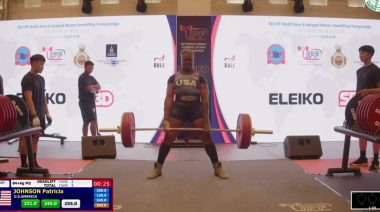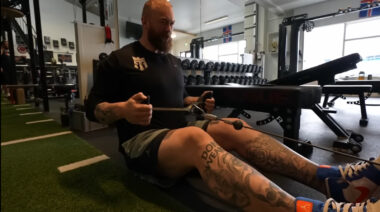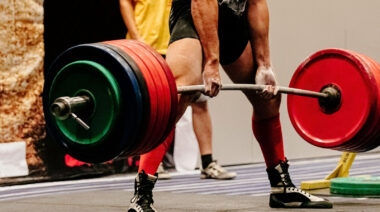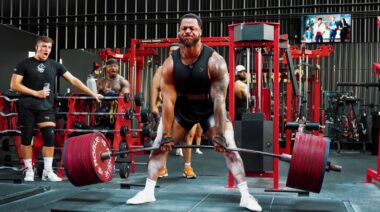It is common for us to think of the leg and back extenders as being the main muscle groups that power the Olympic lifts. As with all forms of weight training, your results in the Olympic lifts will improve with an increase in the absolute strength of your prime movers. If you increase the absolute strength of the leg and back extenders your snatch and clean and jerk will also increase in strength. If this does not happen it is an indication there is something wrong with your training methods. But, does a bigger squat or deadlift always mean a bigger quick lift? Does this generality always hold true?
The answer to that is maybe yes, maybe no. According to Russian coach and writer Anatoli Chernyak, back in 1978 results of statistical research found the following data to be average. These optimum correlations reflect an ideal degree of strength potential realization:
- Snatch = 66-64% of the squat, 38-42% of the deadlift
- Clean = 80-84% of the squat, 54-56% of the deadlift
The lifts mentioned here are the full squat versions. Power version percentages would be about 85% of the full lift. The squat mentioned is the high-back, butt-to-the-floor full squat – otherwise the resultant percentages will not be meaningful. These indices characterize the ultimate utilization of the athlete’s absolute strength potential and they are universal. They can be used for both sexes, all weight categories, and for most levels of athlete excellence. If these ratios are within the above limits, strength utilization potential is considered to be ideally realized. Your training can proceed to the next cycle without modification.
What happens if you get a ratio that is too low? For example, a clean that is only 70% of your squat?
This is a signal that your strength realization has not been effective enough. We all see this with athletes who have an abundance of strength but are not able to fully use it. This would indicate that your technique is below optimal. By “technique” we could mean any part of an incorrect movement pattern, low speed of execution, a poor state of flexibility, a fear of jumping under the bar, and maybe other factors not strictly related to absolute strength. That is what it indicates, but now what should you do about it?
You need technique work. Your coach always tells you how strong you are, and then he adds a “but.” The first thing to realize is that even more absolute strength will not correct this problem. What this kind of ratio really indicates is that your training should include more of the snatch and clean and jerk technique work than would normally be the case. You have to bring the lifts up, by whatever your problem area is. Conversely you can take it easy a bit on the squats and pulls. You may be satisfied to just hold these poundages constant for the next cycle. You are going to have to work on your lifts, not your strength.
Too high a squat compared to your Olympic lifts may indicate your squat poundage used in training was too high and consequently you were doing your squats in too slow a tempo to be useful for the Olympic lifts. Your starting strength is not getting the practice it needs in order to get all those muscle fibers going at the same time. Instead, your squatting is just adding to absolute strength and even to hypertrophy of the legs but not to your leg extension speed.
Same thing with deadlifts and pulls. Often it will be found that you are pulling with too much weight. They look more like deadlifts than cleans. Your traps are growing but your quick lifts are not.
What happens if your ratio is too high? If you are cleaning 90% of your best squat?
If your ratios are that high, then you are over-achieving for your current absolute strength level. Smaller ratios do testify to a greater degree of strength realization ability. The lifter is, in essence, very efficient in converting basic absolute strength into his Olympic lift movements. This is a nice situation to be in. You probably get a lot of compliments on your technique. Your coach may wonder how he got so lucky to have an athlete who gets such good results off a relatively small deadlift. This however is not cause for jubilation.
The more perceptive coach will realize that you have tapped out your strength. Such ratios show a potential for greater strength development, which could in turn lead to greater strength realization down the road. It means that you can be given more strength building exercises with a goal of having your Olympic lifts rise.

Now, the name of the game is not to maintain the same ratio or else you will be forever chasing the same goal. True, a higher pair of Olympic lifts is always welcome regardless of your strength in other lifts. However, that situation is not ideal. The goal is to change the ratio to bring it more into line with what would be optimal. If your absolute strength levels do not rise, your Olympic lift poundages will peak out at some point. The only way out is via the squat rack.
Too high a ratio of quick lifts to squats and deadlifts is often seen in novices and younger lifters whose athletic qualities are good but they just haven’t had time for their absolute strength levels to develop. This will improve with time, training, and maturity. The opposite will be true with those mesomorphic people with average or less athletic ability. They will need to work their technique.

Those who are not competitive lifters will not be as concerned about these ratios as those that are. Although, an athlete’s ratio can be different and still be optimal for his or her primary sporting activity. For example, with CrossFit athletes where the total rep count is important these ratios go out the window completely. Track athletes, especially throwers, may want to correlate their power clean and squat with their length of throw. For example if they’re power cleaning say, 300lbs., that might indicate to them that the throw should be such and such. If it’s not, then the technique probably needs work. Those in speed-oriented sports will want high ratios. Absolute strength oriented athletes will want lower ones.
All of this is why the cultivation of more absolute strength is not the answer to America’s Olympic lifting medal hopes. It worked many years ago when the lifting world was less competitive and less scientifically oriented. It does not work anymore. We have to learn how to lift with speed, that is, with rapid fiber recruitment and technical utilization. Olympic lifting and powerlifting are two separate disciplines. One is not “better” than the other. They are just the epitome of different motive qualities.
References:
1. Chernyak, A. V., Methods of Planning the Training of Weightlifters, Moscow, FiS, 1976.






